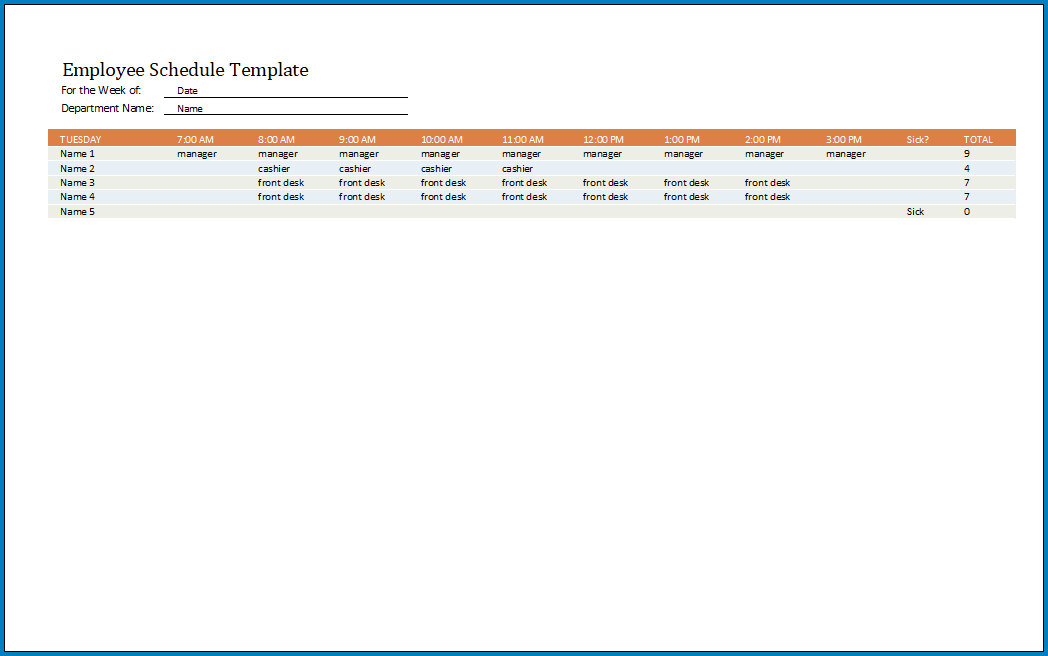
Employee scheduling is a crucial aspect of workforce management that involves aligning staff availability, skills, and preferences with the operational needs of a business. By creating a well-structured schedule, organizations can ensure efficient, cost-effective coverage, improved productivity, and higher employee satisfaction.
This process helps in staffing shifts correctly, preventing overstaffing or understaffing, ensuring compliance with labor laws, reducing errors and administrative burden, and creating a fair and transparent work environment for employees.
What is Employee Scheduling?
Employee scheduling is the process of assigning shifts and tasks to employees based on their availability, skills, and preferences, as well as the operational requirements of the business.
It involves creating a timetable that outlines when each employee is expected to work, taking into account factors such as peak hours, customer demand, and legal regulations.
Samples of Employee Schedule:




Why Employee Scheduling is Important?
Effective employee scheduling is essential for the following reasons:
- Efficient Coverage: By aligning staff availability with business needs, employee scheduling ensures that all shifts are adequately covered, reducing the risk of understaffing or overstaffing.
- Improved Productivity: When employees are scheduled at the right times and in the right roles, productivity levels are optimized, leading to better operational efficiency.
- Higher Employee Satisfaction: By taking into account employee preferences and availability, scheduling can help create a more satisfied and engaged workforce.
- Compliance with Labor Laws: Employee scheduling ensures that organizations adhere to labor laws regarding working hours, breaks, and overtime, reducing the risk of legal issues.
- Reduced Errors and Administrative Burden: A well-organized schedule minimizes errors in shift assignments and reduces the administrative burden associated with managing employee shifts.
- Fair and Transparent Work Environment: Transparent scheduling practices promote fairness and equality among employees, fostering a positive work environment.
What to Include in an Employee Schedule?
An effective employee schedule should include the following components:
- Employee Availability: Collect information on when each employee is available to work, taking into account their preferred hours and days off.
- Skills and Qualifications: Consider the skills and qualifications of each employee when assigning shifts to ensure that the right person is in the right role.
- Operational Needs: Identify peak hours, customer demand, and other operational requirements to schedule staff accordingly.
- Breaks and Rest Periods: Ensure that employees receive adequate breaks and rest periods as required by labor laws.
- Communication: Communicate the schedule clearly to all employees, allowing for feedback and adjustments as needed.
How to Create an Effective Employee Schedule
Follow these steps to create an efficient employee schedule:
- Collect Employee Availability: Gather information on when each employee is available to work, including any preferences or constraints.
- Assess Operational Needs: Analyze the business’s operational requirements, such as peak hours and customer demand, to determine staffing levels.
- Assign Shifts Based on Skills: Match employees to shifts based on their skills, qualifications, and experience to ensure optimal performance.
- Consider Employee Preferences: Take into account employee preferences and requests when creating the schedule to boost morale and engagement.
- Review and Adjust: Regularly review the schedule to identify any issues or conflicts and make adjustments as necessary to optimize staffing levels.
Tips for Effective Employee Scheduling
Consider the following tips to improve your employee scheduling process:
- Use Scheduling Software: Invest in scheduling software to streamline the process and automate shift assignments.
- Communicate Openly: Keep employees informed about their schedules and involve them in the scheduling process to promote transparency.
- Balance Workload: Distribute shifts evenly among employees to prevent burnout and ensure fair workload distribution.
- Plan Ahead: Create schedules in advance to allow for adequate planning and time for adjustments.
- Seek Feedback: Encourage employees to provide feedback on the schedule to address any concerns or preferences.
- Monitor Performance: Track key performance metrics related to scheduling, such as labor costs and productivity, to identify areas for improvement.
Free Employee Schedule Template
An employee schedule is a useful tool for organizing work shifts, managing staff availability, and ensuring smooth daily operations. It helps employers plan coverage, prevent scheduling conflicts, and maintain productivity across all departments. With a clear, easy-to-read layout, this template keeps both managers and employees on the same page.
Download and use our employee schedule template today to streamline scheduling, save time, and keep your workplace running efficiently.
Excel Employee Schedule Template – DOWNLOAD